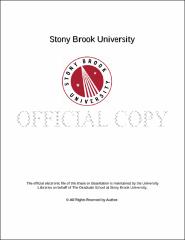| dc.identifier.uri | http://hdl.handle.net/1951/60219 | |
| dc.identifier.uri | http://hdl.handle.net/11401/71487 | |
| dc.description.sponsorship | This work is sponsored by the Stony Brook University Graduate School in compliance with the requirements for completion of degree. | en_US |
| dc.format | Monograph | |
| dc.format.medium | Electronic Resource | en_US |
| dc.language.iso | en_US | |
| dc.publisher | The Graduate School, Stony Brook University: Stony Brook, NY. | |
| dc.type | Dissertation | |
| dcterms.abstract | To develop stem cells based regenerative therapies, more efficient scaffolds are needed. Here we demonstrate how polymeric elastomer scaffolds can be used to induce differentiation of dental pulp stem cells (DPSCs) through surface interactions in the absence of chemical inducers. We show how these elastomers support DPSC proliferation and adhesion when plated directly on the uncoated polymer surfaces. Instead of physically or chemically crosslinking the polymers, we use the principal of entangled polymer surface confinement (EPSC) to continuously vary the substrate modulus and imprint patterns where only the underlying mechanics are varied while the surface chemistry and topography remains unchanged. The ability to continuously vary the mechanics and impose mechanical, topological, and chemical patterns independently provides a distinct advantage to these scaffolds relative to the hydrogel materials currently in use. Using these elastomers, we demonstrated: (1) the principal of EPSC for PB films on Si substrates, and showed that the modulus decreased exponentially with increasing film thickness (2) that EPSC could be used to generate substrates with relatively flat topography, but large differences in mechanical response, and (3) that, in the absence of chemical inducers (dexamethasone; Dex), DPSC are sensitive to differentially small changes in substrate mechanics continuously adjusting their cytoskeleton such that their modulus is always within a factor of 2.5 (p<0.01) of the substrate value. Using a variety of complementary techniques, (SEM/EDX, GIXD, and qRT-PCR), we also found a critical value for the DPSC modulus above which odontogenesis occurred without Dex; Dex induced osteogenesis. Using confocal imaging with immunohistochemistry, we further determined that differentiation occurred in cells not in direct contact with the PB substrate, although cells removed from the mechanical stimulus, deposited CaCO3, rather than hydroxyapatite. Finally, we probed the response of DPSC to mechanical heterogeneity by studying biomineralization on nanoscale and microscale patterns. We found that microscale patterns hindered biomineralization, even in the presence of Dex, while nanoscale patterns promoted biomineralization, even without Dex. Hence, it was not clear whether cells with different degree of differentiation could be co-cultured and self-assembled on the same substrate through mechanical templating. | |
| dcterms.available | 2013-05-24T16:38:15Z | |
| dcterms.available | 2015-04-24T14:47:44Z | |
| dcterms.contributor | Jurukovski, Vladimir | en_US |
| dcterms.contributor | Rafailovich, Miriam H | en_US |
| dcterms.contributor | Sokolov, Jonathan | en_US |
| dcterms.contributor | Simon, Marcia. | en_US |
| dcterms.creator | Chang, Chung-Chueh | |
| dcterms.dateAccepted | 2013-05-24T16:38:15Z | |
| dcterms.dateAccepted | 2015-04-24T14:47:44Z | |
| dcterms.dateSubmitted | 2013-05-24T16:38:15Z | |
| dcterms.dateSubmitted | 2015-04-24T14:47:44Z | |
| dcterms.description | Department of Materials Science and Engineering | en_US |
| dcterms.extent | 78 pg. | en_US |
| dcterms.format | Monograph | |
| dcterms.format | Application/PDF | en_US |
| dcterms.identifier | http://hdl.handle.net/1951/60219 | |
| dcterms.identifier | http://hdl.handle.net/11401/71487 | |
| dcterms.issued | 2012-08-01 | |
| dcterms.language | en_US | |
| dcterms.provenance | Made available in DSpace on 2013-05-24T16:38:15Z (GMT). No. of bitstreams: 1
StonyBrookUniversityETDPageEmbargo_20130517082608_116839.pdf: 41286 bytes, checksum: 425a156df10bbe213bfdf4d175026e82 (MD5)
Previous issue date: 1 | en |
| dcterms.provenance | Made available in DSpace on 2015-04-24T14:47:44Z (GMT). No. of bitstreams: 3
StonyBrookUniversityETDPageEmbargo_20130517082608_116839.pdf.jpg: 1934 bytes, checksum: c116f0e1e7be19420106a88253e31f2e (MD5)
StonyBrookUniversityETDPageEmbargo_20130517082608_116839.pdf.txt: 336 bytes, checksum: 84c0f8f99f2b4ae66b3cc3ade09ad2e9 (MD5)
StonyBrookUniversityETDPageEmbargo_20130517082608_116839.pdf: 41286 bytes, checksum: 425a156df10bbe213bfdf4d175026e82 (MD5)
Previous issue date: 1 | en |
| dcterms.publisher | The Graduate School, Stony Brook University: Stony Brook, NY. | |
| dcterms.subject | Materials Science--Biomedical engineering | |
| dcterms.title | Using Biomechanics to study cell behavior | |
| dcterms.type | Dissertation | |

